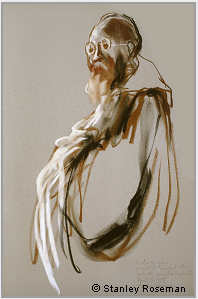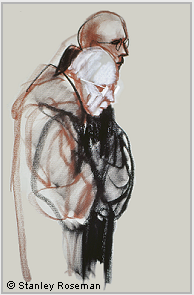
|
Monastic Journey
Continued |
|||||
Stanley Roseman
The MONASTIC LIFE
The MONASTIC LIFE
© Stanley Roseman and Ronald Davis - All Rights Reserved
Visual imagery and website content may not be reproduced in any form whatsoever.
Visual imagery and website content may not be reproduced in any form whatsoever.
Returning to England - Page 2
Please note that the website has been republished for Internet Explorer 11.
See also Roseman's paintings and drawings from monasteries in England:
"The Monastic Life," Page 1 - "The Artist begins his Work;"
"Benedictines, Cistercians, Trappists, and Carthusians," Page 5 - "Carthusians;"
"Correspondence from the Monasteries;" and "From the Artist's Memoirs."
"The Monastic Life," Page 1 - "The Artist begins his Work;"
"Benedictines, Cistercians, Trappists, and Carthusians," Page 5 - "Carthusians;"
"Correspondence from the Monasteries;" and "From the Artist's Memoirs."
Dom Sylvester Mooney, Abbot Emeritus, 1984
Douai Abbey, England
Chalks on paper, 50 x 35 cm
British Museum, London
Douai Abbey, England
Chalks on paper, 50 x 35 cm
British Museum, London
"I am deeply appreciative to Father Gerard for the time he kindly gave me for my work," writes Roseman, whose sentiment was reciprocated when Dom Gerard thoughtfully wrote in a letter to the artist: "My Dear Stanley. . . I was very pleased and felt honoured when you wanted to draw me. . . ."
3. Dom Gerard Sitwell, 1983
Ampleforth Abbey, England
Chalks on paper, 50 x 35 cm
Collection Ampleforth Abbey
Ampleforth Abbey, England
Chalks on paper, 50 x 35 cm
Collection Ampleforth Abbey
At the Benedictine Abbey of Ampleforth, Yorkshire
Dom Gerard, a graduate of Ampleforth's secondary school and Oxford University, was for some seventeen years at Oxford, Master of St. Benet's Hall, founded by Ampleforth Abbey in 1897 for undergraduate and graduate students. Dom Gerard was a translator, editor, and author, whose work includes Medieval Spiritual Writers and St. Odo of Cluny by the tenth-century monk John of Salerno, as well as articles for the Encyclopaedia Britannica and the Dictionaire de Spiritualité.
Roseman met Dom Gerard in his retirement years at Ampleforth Abbey. The erudite monk was greatly encouraging to the artist for his work on monastic life and his studies on monastic history. "Father Gerard invited me to join him on his walks in the Yorkshire countryside," writes Roseman, "and his enlightening conversations were always a learning experience for me."
With a cordial invitation in 1983 from Abbot Ambrose Griffiths of Ampleforth Abbey, Roseman and Davis traveled to Yorkshire. The artist's work at Ampleforth includes a commissioned oil on canvas portrait of the distinguished abbot for the monastery. Abbot Ambrose gives Roseman a great compliment when he writes to him and says: ". . . being painted by you has been a truly wonderful experience."
In Roseman and Davis' journeys to monasteries, they made gifts of the artist's drawings in appreciation of the gracious hospitality received and for the encouragement of their work. Abbot Ambrose writes a letter of appreciation for the gift to the monastery of the "very fine drawing" Dom Gerard Sitwell, (fig. 3, below).
Having drawn Dom Gerard in choir, the artist asked the monk if he could draw him again on their return to the monastery from one of their walks together.
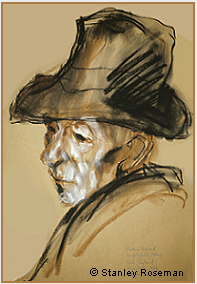
In the portrait Dom Gerard Sitwell vigorous strokes of black and bistre chalks describe the wide-brimmed hat and the collar of the monk's black overcoat. The ochre paper imbues the composition with a warm tonality. The artist renders the subject's facial features with the blending of black and bistre chalks and with passages of white chalk that capture a strong, northern, wintry light on the ascetic monk's face seen in three-quarter profile. This deeply felt portrait depicts the Benedictine monk in a moment of introspection.
Abbot Ambrose writes to the artist: "Thank you very much for your wonderful letter and your kind words. It is very good of you to give us your very fine drawing of Father Gerard. I realize how much the drawing means to you and that makes the gift all the greater. . . .''
The Oldest Living Monk in the twentieth-century Western Church
Roseman was invited in 1984 to the Benedictine Abbey of Douai, in Upper Woolhampton, Reading, where he drew Abbot Emeritus Dom Sylvester Mooney, whose magnificent portrait, acquired by the British Museum, is presented below, (fig. 6).
Dom Sylvester, one of the most revered churchmen in Great Britain, was Abbot of Douai for forty years: through the Depression, the Second World War, and the post war years, until his retirement in 1969. When Roseman drew Dom Sylvester, he was ninety-eight years old and the oldest living monk in the Western Church.
Although Dom Sylvester was advanced in years, the erudite, English abbot was lucid of mind and still a vital presence in the Community. He participated in the Divine Office in choir and took his meals with the monks in the refectory. Dom Sylvester spoke highly of Roseman's talents as a draughtsman and the artist's deep understanding of monastic life. In a gracious gesture, the Abbot Emeritus honored Roseman by seating the artist next to him at his table in the refectory.
Dom Sylvester invited Roseman to draw him in his room, and over a number of memorable days, the artist drew several superb portraits of the Abbot Emeritus.
Drawing with a combination of chalks on gray paper, the artist renders the face of the elderly abbot with white highlights and warm shading. Several strokes of black chalk define the monk's black scapula with hood lowered. Roseman's masterly drawn portrait has an immediacy of lively expression as Dom Sylvester looks directly out at the viewer.
6. Dom Sylvester Mooney,
Abbot Emeritus
1984, Douai Abbey, England
Chalks on paper, 50 x 35 cm
British Museum, London
Abbot Emeritus
1984, Douai Abbey, England
Chalks on paper, 50 x 35 cm
British Museum, London
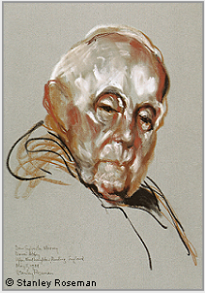
The portrait Dom Sylvester Mooney, Abbot Emeritus, entered the British Museum in 1996 with the artist's portrait drawing of Abbess Mary Imelda of the Trappist Abbey of Glencairn, Ireland, and a drawing of Paris Opéra star dancer Kader Belarbi from Roseman's extensive oeuvre of drawings on the dance at the Paris Opéra.
The Deputy Director of the British Museum, Jean Rankine, acknowledging the acquisition of Roseman's drawings on behalf of the Trustees, writes in her cordial letter to the artist: ''At their last meeting the Trustees of the British Museum had before them a report of your gift to the Department of Prints and Drawings of three drawings by yourself: Mother Mary Imelda, Abbess of Glencairn, Ireland (1978); Dom Sylvester Mooney, Abbot Emeritus, Douai Abbey, Reading (1984); and Kader Belarbi, Ballet de l'Opéra de Paris, 'Petrouchka' (1994).
''I am directed by the Trustees to convey to you this expression of their best thanks
for these most welcome additions to their collections.''
for these most welcome additions to their collections.''
- Jean Rankine, Deputy Director
British Museum, London
British Museum, London
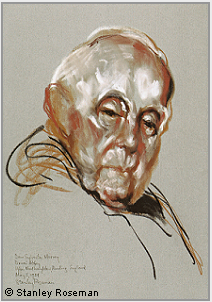
For the occasion of Dom Sylvester's 100th birthday on June 11, 1986, Roseman and Davis made a gift of a portrait drawing by the artist of the Abbot Emeritus to Douai Abbey. In letter of appreciation, Dom Geoffrey Scott, librarian and archivist, who was to be elected Abbot of Douai in 1998, writes "on behalf of Fr Sylvester, Fr Abbot and the Community:
"We collected the drawing of Fr Sylvester yesterday afternoon and are delighted with it.
I'd not seen the drawing before and was struck by its power. It is very hard to thank you adequately for such a noble gift which will be a treasured possession of the community
through succeeding generations."
I'd not seen the drawing before and was struck by its power. It is very hard to thank you adequately for such a noble gift which will be a treasured possession of the community
through succeeding generations."
- Dom Geoffrey Scott, OSB
Abbot of Douai (1998 - )
Abbot of Douai (1998 - )
From Roseman's series of drawings at St. Augustine's Abbey is the portrait Dom Bede, 1980, (fig. 2, below), acquired for the Victoria and Albert Museum, London, by Susan Lambert, Senior Curator of Prints, Drawings, and Paintings, who praises the drawing as "an excellent example of modern portraiture."
The distinguished Curator Susan Lambert, writes in November 1994 with enthusiasm and appreciation to Davis, who had initiated the proposed gift:
"I am writing to thank you for your gift of the drawing of Dom Bede by Stanley Roseman. We are very pleased to be able to represent his work in this Collection. The identity of the sitter, Dom Bede, gives the drawing a particular significance since Dom Bede collaborated in the recent Pugin exhibition. The drawing is also an excellent example of modern portraiture. In terms of its subject, medium, and intrinsic quality the drawing fits extremely well into the V&A's collecting policy and is a notable acquisition."
- Susan Lambert
Senior Curator of Prints, Drawings, and Paintings
Victoria and Albert Museum, London
Senior Curator of Prints, Drawings, and Paintings
Victoria and Albert Museum, London
2. Dom Bede,
Portrait of a Benedictine Monk
1980, St. Augustine's Abbey, England
Chalks on paper, 35 x 50 cm
Victoria and Albert Museum,
London
Portrait of a Benedictine Monk
1980, St. Augustine's Abbey, England
Chalks on paper, 35 x 50 cm
Victoria and Albert Museum,
London
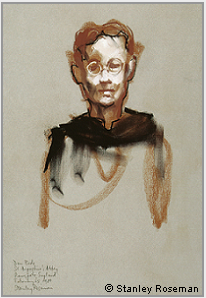
RETURNING
to ENGLAND
Continued
to ENGLAND
Continued
The portrait of Brother Augustine, an amiable, bearded Dutchman, is rendered in a combination of chalks on gray paper of the hooded hermit monk in prayer. Roseman recalls, "I drew Brother Augustine in choir, and I also drew him in his hermitage, where he kindly invited me for a walk in the beautiful, trellised garden he had designed, built, and cultivated - a meditative, outdoor space in the confines of his hermitage.''
Portrait of a Carthusian Monk in Prayer and an equally fine portrait of Brother Augustine, also from the Order's ninth centenary year, are conserved in the Teyler Museum, the Netherlands. The museum houses a renowned collection of Italian Renaissance master drawings, including works by Michelangelo and Raphael, and the Seventeenth-Century Dutch School, notably drawings by Rembrandt.
The portrait drawings of the Carthusian monk from Parkminster joined earlier acquisitions from Roseman's work on the monastic life as well as other subjects from the artist's extensive corpus of drawings. In letter of November 1989 to Davis, the Curator Carel van Tuyll praises "the splendid portraits of monks" and concludes, "it is a cause of profound gratitude on our part to be able to show such an excellent group of Mr. Roseman's drawings.''
5. Portrait of a Carthusian Monk
in Prayer, 1984
St. Hugh's Charterhouse
Parkminster, England
Chalks on paper, 50 x 35 cm
Teylers Museum, The Netherlands
in Prayer, 1984
St. Hugh's Charterhouse
Parkminster, England
Chalks on paper, 50 x 35 cm
Teylers Museum, The Netherlands
- Carel van Tuyll, Chief Curator
Teylers Museum, The Netherlands
Teylers Museum, The Netherlands
Portraiture
Portraiture holds an important place in Roseman's oeuvre. In a Sunday magazine cover story, 1979, on the artist, the leading Swedish daily Aftonbladet, Stockholm, commends Roseman for creating portraits "artistically on a high level as well as accurately expressive of the human dimension.''
Roseman has devoted much of his professional life to drawing, considered the foundation of the visual arts. Giorgio Vasari, the celebrated, sixteenth-century Florentine architect, painter, and author, states in the preface to his series of biographies Lives of the Artists that drawing (disegno) is ''the parent of our three arts, Architecture, Sculpture, and Painting, having its origin in the intellect.''[1] Although drawings have traditionally served as studies or drafts in preparation for compositions to be realized in another medium, drawings can be autonomous works of art, as are Roseman's drawings.
Returning to St. Augustine's Abbey, Kent
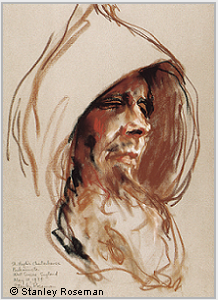
Sojourns at St. Hugh's Charterhouse, Parkminster, West Sussex
St. Hugh's Charterhouse, known as Parkminster, is located in the countryside of West Sussex. The Carthusian Order provides for the solitary life of the hermit within the context of a monastic community. In a text to accompany his work on the monastic life, Roseman writes of the Carthusians: "Living in hermitages and observing the principles of obedience, humility, and silence prescribed in the Rule of St. Benedict, the Carthusians follow an eremitic ideal inspired by the Desert Fathers."
The Prior of Parkminster, Dom Bernard O'Donovan, wrote in January of 1983 a cordial letter of invitation to Roseman and Davis. Addressing his letter to Davis, who had written to introduce Roseman's work on the monastic life and to explain their request for a visit, the Prior Dom Bernard writes: "I congratulate your friend and yourself on this good work.''
Dom Bernard invited Roseman and Davis to return to St. Hugh's Charterhouse the following year for the artist to resume drawing in the monastery. The Prior cordially writes: "I shall be pleased to have you here for the dates you mentioned. . . . I look forward to meeting you both again. . . . God bless. Fr. Bernard."
At Parkminster, Roseman drew the impressive Portrait of a Carthusian Monk in Prayer, 1984, (fig. 5).
4. Portrait of a Carthusian Monk
1984, St. Hugh's Charterhouse
Parkminster, England
Chalks on paper, 50 x 35 cm
Mead Art Museum, Amherst College
Amherst, Massachusetts
1984, St. Hugh's Charterhouse
Parkminster, England
Chalks on paper, 50 x 35 cm
Mead Art Museum, Amherst College
Amherst, Massachusetts
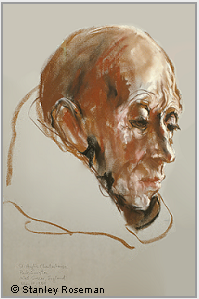
From Roseman's drawings at Parkminster on the Carthusian Order's ninth centenary year is Portrait of a Carthusian Monk, 1984, (fig. 4), a deeply felt portrait of a hermit monk.
Dom Bede, who was Assistant Procurator for thirty years, had befriended the artist and his colleague on their first sojourn at Parkminster. A kindly monk, Dom Bede thoughtfully brought Roseman and Davis to the library, where, as the artist recalls, "Dom Bede showed us wonderful rare books and manuscripts, including a 12th-century Gradual containing music for the Mass, and he kindly assisted us in our research and study on the Carthusian Order."
Portrait of a Carthusian Monk was acquired in 1986 by the Mead Art Museum, Amherst, Massachusetts, the state in which the artist was born. The Amherst College Museum's collection is noted for works on paper by American artists. Roseman's portrait entered the collection with his drawing from the Benedictine Abbey of St. Stephan, Augsburg. "I am very pleased with the drawings,'' writes the Museum's Director Frank Trapp in acknowledging "this fine gift to the collection of Amherst College.''
In the present work, Dom Bede is depicted in three-quarter profile with warm shading enhanced by white highlights on the face of the Carthusian monk. A few strokes of bistre chalk define the monk's hood lowered on his shoulders. With painterly, chiaroscuro modeling of the chalks complemented by fine linear description, Roseman created a superb portrait that conveys the asceticism and inner being of a man who has dedicated his many years to the contemplative life.
Roseman and Davis kept in touch with Dom Bede and were very appreciative when the hermit monk wrote in a thoughtful card:
"To Stanley and Ronald, Affectionate Easter Greetings
from all your friends at St. Hugh's. fr Bede"
from all your friends at St. Hugh's. fr Bede"
The preceding page concludes with a portrait of Dom Francis from the Anglican Benedictine Abbey of Elmore. The following selection presents portraits of Benedictine, Trappist, and Carthusian monks whom Roseman also drew on his returns to monasteries in England.
Dom Bede, Portrait of a Benedictine Monk, drawn in a combination of chalks, was a gift to the Victoria and Albert Museum from Roseman and Davis in memory of their friend who passed away in 1993. Dom Bede Millard was a skilled craftsman in church vestments, extremely knowledgeable on Pugin, and contributed the chapter on 'Ecclesiastical Textiles' for the Museum's Pugin exhibition catalogue published in 1994. The catalogue is dedicated to Dom Bede.
The Divine Office
The Rule of St. Benedict, Chapter 16, instructs that the Divine Office, central to the monastic life, adhere to the Prophet's call to prayer from the Book of Psalms. "At midnight I rise to praise you, O Lord," and "Seven times a day I praise you,'' states the Prophet in Psalm 119, subtitled "In praise of the divine Law.''[2]
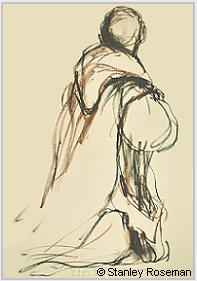
Vigils
7. A Carthusian Monk
kneeling in Prayer at Vigils
1983, St. Hugh's Charterhouse,
Parkminster, England
Chalks on paper, 50 x 35 cm
Collection St. Hugh's Charterhouse
kneeling in Prayer at Vigils
1983, St. Hugh's Charterhouse,
Parkminster, England
Chalks on paper, 50 x 35 cm
Collection St. Hugh's Charterhouse
At Parkminster in winter 1983, the Prior invited Roseman to draw the monks at Vigils. The artist relates in the text he wrote on Parkminster that each night, shortly before half-past twelve, the Prior came up to his room to bring him to the Night Office. With a flashlight Dom Bernard led Roseman down the darkened stairwell and through the long, dark cloister, "like a freezing, vaulted tunnel through the monastery," writes the artist.
"Escorting me into church as the hermit monks were entering from the sacristy, the Prior brought me into the choir stalls to sit with the community. . . .
"The monks took large, leather-bound Psalters from shelves of the choir stalls, placed the books on top of the railings in front of them, and opened the Psalters with which they chanted the Night Office. The Prior tapped his ring on the side of his choir stall, and the monks stood for silent prayer. At a second tap of the Prior's ring, the cantor led the invocation from Psalm 51: 'Lord, open my lips.' The monks responded in unison, 'And my mouth will proclaim Your praise.' "
At Vigils, from 12:30 to 3:00 a.m., Roseman drew the hermit monks while they chanted the Psalms and read from the Scriptures, stood, bowed, knelt, and prayed in the night.
A Carthusian Monk kneeling in Prayer at Vigils, (fig. 7), depicts the hermit turned towards the altar and kneeling in prayer. The pyramidal composition is reaffirmed in the leitmotif of the triangular shape of the monk's hood and the folds of his voluminous habit. The Carthusians wear habits of undyed wool, the color of which is suggested by the use of beige paper. With fluent lines of black and bistre chalks, Roseman creates a compelling image of a monk kneeling in prayer.
"O come, let us worship and bow down: let us kneel before the Lord our maker.''
- from Psalm 95, sung at Vigils
Lauds
8. Two Benedictine Monks
at Lauds, 1999
Elmore Abbey, England
Chalks on paper, 50 x 35 cm
Private collection, Switzerland
at Lauds, 1999
Elmore Abbey, England
Chalks on paper, 50 x 35 cm
Private collection, Switzerland
Compline
- from Psalm 67, sung at Lauds
"The drawings make their own positive affirmation which is, I believe, comprehensible to every person of goodwill, whatever his nationality or creed. Hence the publication of the drawings seems to me to be much more than an appropriate conclusion to a long project, but rather a positive statement of values that need to be affirmed and safeguarded as fundamental to all that is best, noblest and most profound in the spirit of man."
- Dom Wilfrid Weston, OSB
Abbot of Nashdom
A deeply meaningful Letter from the Abbot of Nashdom about Roseman's Work
"Your drawings are, I believe, of great significance for all who seek to know the meaning of man's life and what constitutes its highest values and deepest insights.
"The monk is always searching for something which must inevitably lie in some measure beyond his comprehension, as it is an exploration into the meaning of life itself.
Abbot Wilfrid Weston had invited Roseman and Davis to the Anglican Benedictine Abbey of Nashdom in February 1983 and graciously extended a second invitation to enable the artist to further his work in the monastery. Following their departure in March, Abbot Wilfrid writes: "It was a great joy to have you both back with us for a second visit.'' The Abbot goes on to speak about the monk's vocation and commends Roseman for his work on the monastic life:
"I will say of the Lord, 'He is my refuge and my fortress:
my God; in him I will trust.' "
my God; in him I will trust.' "
- from Psalm 91, sung at Compline
The series of fine drawings from Roseman's sojourn with the Anglican monks at the Benedictine Abbey of Elmore, in Berkshire, includes the present work Benedictine Monks at Lauds, 1999, (fig. 8). In his text on monastic life and his work in monasteries, Roseman writes of the Judeo-Christian tradition of Psalmody and the canonical hours:
"Lauds, traditionally sung at daybreak, is the first of the daytime round of prayers that along with Vigils constitute the Divine Office. Lauds derives its name from the Latin 'laudes,' or 'praises,' for Psalms 148, 149, and 150, sung at the Morning Office, begin by praising the Lord.
"Carrying my drawing book and box of chalks, I accompanied the community to draw the monks at Lauds. In the Rule of St. Benedict, Chapters 12 and 13 give the order and number of Psalms to be sung at Lauds on Sundays and on the following days of the week. The last three Psalms in the Psalter, the Psalms of praise 148, 149, and 150, are sung daily, as are Psalms 51 and 67. The Rule of St. Benedict prescribes for each day additional Psalms at Lauds, such as Psalm 5 sung with the affirmation to God: 'in the morning I will direct my prayer to you.' The Rule also prescribes to be sung at Lauds each morning a canticle from the Old Testament, such as from Deuteronomy and from the Prophets.''
Mount St. Bernard Abbey, the first Trappist monastery where Roseman drew at the outset of his work on the monastic life in 1978, was again most welcoming when he and Davis returned to England in 1984. From the artist's series of excellent drawings on that return to the abbey in Leicestershire is Father Gregory at Compline, presented below, (fig. 9). The artist accompanied the Trappist monks to Compline, the last office of the day. Roseman recounts:
"Let the people praise you, O God, let all the people praise you."
Two Benedictine Monks at Lauds, drawn in black, white, and bistre chalks, is an arresting composition with the placement of the two standing figures in pictorial space. In the foreground, the figure stands with head inclined in a humble gesture of prayer. Here Roseman draws with fluent lines that gradate from fine to broad strokes and transparent passages of black chalk. Reserved areas of the gray paper impart a cool sheen to the voluminous cowl. In contrast, the taller, younger monk stands erect facing the altar, his cowl drawn with solid areas of black chalk that gives the composition a strong verticality. This impressive drawing conveys the spirituality of two men of different ages, each absorbed in prayer at the Divine Office.
"Drawing at Compline, I heard Psalms 4, 91, and 134 sung by the community, for the Rule of St. Benedict prescribes those three Psalms to be sung each evening. As the day is brought to a close, the Psalms of Compline bless the Lord and ask God for protection in the dark.
9. Father Gregory at Compline
1984, Mount St. Bernard Abbey
England
Chalks on paper, 50 x 35 cm
Private collection
1984, Mount St. Bernard Abbey
England
Chalks on paper, 50 x 35 cm
Private collection
In this beautiful drawing, Roseman depicts Father Gregory, a monk in his senior years, who has concluded his daytime activities of prayer, work, and study, and with eyes gazing towards the altar, offers his prayers at Compline: "for only you, Lord, make me dwell in safety.'' (Psalm 4:8)
Father Gregory at Compline portrays the bespectacled, white-bearded Trappist monk with hands tucked into the voluminous sleeves of his white cowl as he stands in choir. Roseman renders the figure with vibrant, chiaroscuro modeling of the chalks that complement highlights on the monk's face, rims of his glasses, and full beard with warm shading in bistre and red chalks, deepened with passages of black. Cascading strokes of white chalk describe the fall of light on the monk's cowl. Fine lines in bistre chalk delineate the monk's hood and cowl, while broad, fluent black strokes define shadows. The artist reserves areas of the gray paper to suggest a mid tone between light and shade.
1. Giorgio Vasari , Vasari on Technique (New York: Dover Publications, Inc., 1960), p. 205.
2. The Psalter is comprised of one hundred and fifty Psalms. Psalms 10 to 148 in the Hebrew Bible are one number ahead of the Greek
Septuagint and Latin Vulgate Bibles. The Greek and the Vulgate combine Psalms 9 and 10 as well as Psalms 114 and 115 while
separating into two parts each Psalm 116 and Psalm 148. The Rule of St. Benedict uses the numbering of the Psalms in the Vulgate Bible.
2. The Psalter is comprised of one hundred and fifty Psalms. Psalms 10 to 148 in the Hebrew Bible are one number ahead of the Greek
Septuagint and Latin Vulgate Bibles. The Greek and the Vulgate combine Psalms 9 and 10 as well as Psalms 114 and 115 while
separating into two parts each Psalm 116 and Psalm 148. The Rule of St. Benedict uses the numbering of the Psalms in the Vulgate Bible.
